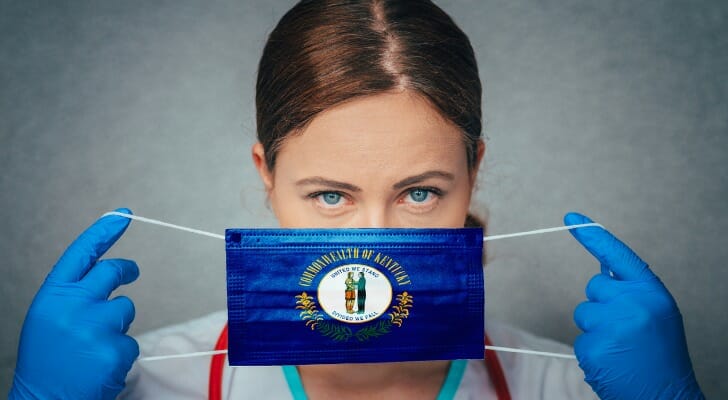Kentucky Coronavirus Relief Programs
Compared to neighboring states Ohio and Tennessee, Kentucky has had far fewer coronavirus cases so far. Some counties have yet to tally even one case, though epidemiological modeling forecasts that the state is still a...Monday, April 20th 2020, 10:04 am
By Caroline Hwang, CEPF®
Compared to neighboring states Ohio and Tennessee, Kentucky has had far fewer coronavirus cases so far. Some counties have yet to tally even one case, though epidemiological modeling forecasts that the state is still a month away from its caseload peak.
The slower spread of the virus is thanks in large part to the aggressive social distancing orders that the state government issued early on. Since mid-March, restaurants and bars have been closed to in-person traffic and businesses that encourage public congregation have stopped operations. All non-life-sustaining businesses were temporarily shuttered on March 26.
But what has been great for public health has been detrimental to business – and employees. As of April 14, more than half a million Kentuckians have filed for unemployment insurance. At the same time, many small businesses are scrambling to apply for emergency loans under federal relief programs.
To help Kentuckians – individuals, families and businesses – get through these difficult times, SmartAsset has put together this guide on new or enhanced state and federal assistance programs. But for hands-on help with your finances and investments, it may be a good time to hire a financial advisor.
Kentucky Coronavirus Relief for IndividualsAlong with its ahead-of-the-curve social distancing measures, the state has issued changes to existing assistance programs, suspended evictions from homes and ordered insurance companies not to charge co-pays or other fees for COVID-19-related services.
Waived Health Insurance Fees for COVID-19 Testing and TreatmentThe governor has issued an executive order that mandates private insurance companies to waive copays, deductibles, cost-sharing and diagnostic testing fees related to COVID-19. This applies to hospital, emergency department, urgent care, provider office visits, lab testing, telehealth and any immunizations that are made available. The waiver covers state employees, too.
Unemployment Insurance for Kentucky Coronavirus ReliefOrdinarily, unemployed Kentuckians must wait seven days before becoming eligible for unemployment insurance (UI). But during the state of emergency and under the governor’s executive order, the waiting has been waived, as have any work search requirements. Additionally, federal legislation has expanded UI coverage to independent contractors, gig-economy workers, substitute teachers and childcare workers employed by religious-affiliated organizations and nonprofits – and to people who must leave their jobs because they are at risk of exposure and must self-quarantine or have to care for a family member affected by COVID-19. Federal law has also extended the amount of time you can receive UI and how much you can receive (explained in the federal section below).
To apply for UI in Kentucky, go here.
Medicaid for Kentucky Coronavirus ReliefIf you’ve lost your health benefits along with your job, you can immediately apply for Medicaid now. This program is temporary and ends on June 30, 2020, unless you apply for regular Medicaid.
To apply for Kentucky Medicaid, go here.
Paid Sick Leave for Kentucky Coronavirus ReliefWhile the state has only encouraged private employers to provide paid sick leave to workers affected by COVID-19, it is providing up to 10 days of paid sick leave to state employees who are exhibiting symptoms or have been exposed to coronavirus.
Eviction Moratorium for Kentucky Coronavirus ReliefTo help Kentuckians stay healthy – which means staying home – the governor has temporarily suspended all evictions. No state, county or local law enforcement officer will enforce orders of evictions from residences during the declared state of emergency.
Workers’ Compensation for Kentucky Coronavirus ReliefIf a doctor advised you to leave work due to occupational exposure to COVID-19, you may be entitled to temporary disability payments. Other limitations have been lifted, so that payments should begin immediately. These changes to workers’ compensation will primarily affect military, active National Guard, childcare workers, grocery workers, corrections officers, domestic violence shelter workers, child advocacy workers, rape crisis center workers, postal workers and Department of Community Based Services workers.
Kentucky Coronavirus Relief for Small BusinessesLast March, the Small Business Administration (SBA) certified the entire state as a disaster area. This allows small businesses (500 or fewer employees) to qualify for
Economic Injury Disaster Loans (described in the federal section, below). There have also been some Louisville programs for small businesses. We describe the one that offers financial assistance. (We’ll add more as we find them.)
Louisville businesses with 10 or fewer employees are eligible for zero-interest, 12-month loans for up to $25,000. The program is administered by the Louisville Housing Opportunities and Micro-Enterprise Community Development Loan Fund, Inc. (LHOME). To qualify for the bridge loan, you’ll need to be located in Jefferson County, show that your emergency is connected to the coronavirus crisis, be in good standing with the Louisville Metro Revenue Commission, agree to sign up for financial coaching and apply for other financial assistance within 90 days of loan closing.
For more information, go here.
Federal Coronavirus Relief for IndividualsBy far, the most popular federal relief program for individuals provides cash (also called stimulus checks or Economic Impact Payments) to most Americans, whether they file taxes or not. Generally, individuals whose adjusted gross income (AGI) is $75,000 or less are entitled to $1,200 and married couples with an AGI of $150,000 or less are entitled to $2,400 – plus you get $500 per dependent child. People who earn more, up to a cap, will receive a reduced amount. To find out how much you’ll get, use our calculator. You can learn more, including when you’ll get your payment if you haven’t already (the IRS began direct deposits this week) and how to get it faster (if the IRS doesn’t have your bank information), here.
To encourage people to stay home if they have contracted COVID-19 and help those who live with someone who has, the federal government has mandated the country’s first national paid sick leave policy. If you work for a company with 500 or fewer employees and meet certain requirements, you are eligible for up to two weeks of sick leave paid at your regular rate (capped at $511 per day). You may also be eligible for two weeks of sick leave paid at two-thirds your pay rate (capped at $200 per day) if you can’t work because you have to care for someone who has COVID-19 or for a child whose school is closed. Parents are entitled also to 10 additional weeks at two-thirds their regular pay if their child’s school remains closed or childcare is unavailable. Read more about the changes to paid sick leave and family and medical leave.
Additionally, federal legislation has extended unemployment insurance to workers who don’t normally qualify: independent contractors, freelancers, gig workers and part-time workers. It also provides a boost of $600 per week. Learn more here.
Federal Coronavirus Relief for Small BusinessesIf you own a small business, you’ve probably heard about the Paycheck Protection Program (PPP), and already applied for a loan. The Small Business Administration (SBA) has already approved loans for $230 billion of the $349 billion allocated to the program – and will certainly need more funding. If you haven’t already applied, you’ll likely have to wait for Congress to approve more funding for the program. In the meantime, you can find out more about the PPP program, how much you can borrow and a list of PPP loan lenders (if your bank isn’t an SBA lender).
Another major federal program for businesses impacted by the COVID-19 pandemic provides Economic Injury Disaster Loans (EIDLs). This SBA program actually existed before, and under it, small business owners in areas that have been declared and certified as economic disaster zones can get loans for up to $2 million (because of a funding shortfall, initial disbursements are capped at $15,000 for two months). One significant change due to the coronavirus crisis, though, is that they can get $10,000 advances that are forgivable if certain requirements are met. Also, the interest rate has been set at 3.75% for businesses and 2.75% for non-profits. The loan term can be for up to 30 years. To apply, for an EIDL, go to SBA’s site.here. You can learn more about EIDLs here.
For businesses with existing SBA loans, there is an automatic debt relief program. For six months, the SBA will cover all payments, including principal, interest and fees. Check with your lender to make sure your loan is covered.
If you are waiting on an EIDL, the SBA has express bridge loans for up to $25,000 to keep your business afloat until the larger loan arrives. The EIDL money will then be used to pay back this express loan. You can apply for this loan with a local lender.
Finally, existing programs like the 7(a) loan program, the express loan program, 504 loans, Community Advantage Loans and microloans are all still available.
Tips for Managing Your Finances During the COVID-19 Crisis- Could you use a financial professional’s help during these unprecedented times? Use SmartAsset’s financial advisor matching tool to find the right pro for you. After you answer a handful of questions, we’ll connect you with up to three advisors who fit your needs and preferences.
- Perhaps the one positive about the current crisis: falling mortgage rates. If you’re thinking of refinancing your mortgage, use our calculator to see how much you’ll save. Also, learn more about refinancing basics here.
Photo credits: ©iStock/kovop58, ©iStock/sam thomas, ©iStock/ClarkandCompany
The post Kentucky Coronavirus Relief Programs appeared first on SmartAsset Blog.
Information contained on this page is provided by an independent third-party content provider. Frankly and this Site make no warranties or representations in connection therewith. If you are affiliated with this page and would like it removed please contact pressreleases@franklymedia.com
More Like This
April 20th, 2020
April 19th, 2024
April 19th, 2024
April 19th, 2024
Top Headlines
April 19th, 2024
April 19th, 2024










